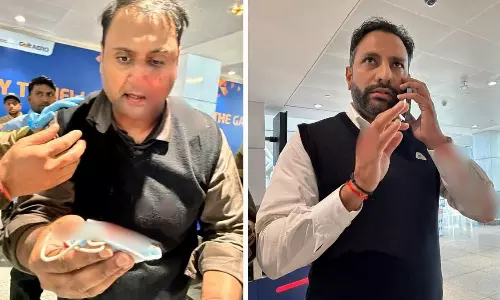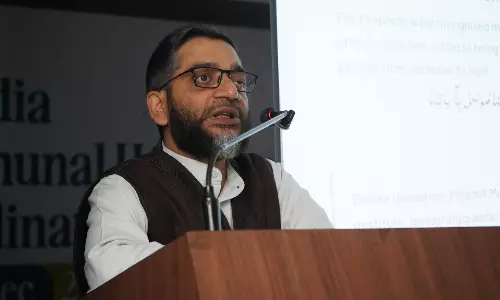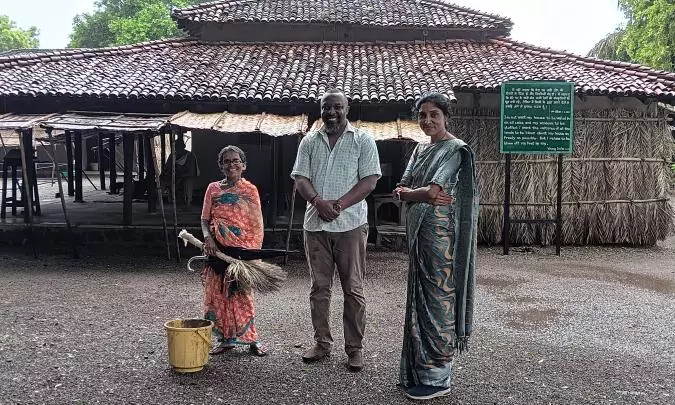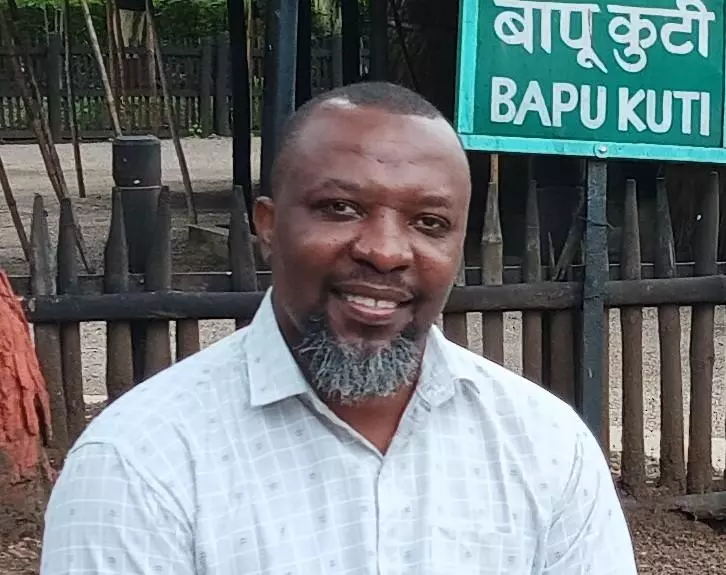
A journey of discovery: Tracing the footsteps of Gandhi
text_fieldsAly Harre Ruwa, Karuna, and Ashram assistant standing next to Gandhi’s first residence
My first encounter with Mohandas Karam Chand Gandhi happened when I was in primary school. He was famous for his achievements in fighting against racial segregation in South Africa and the Indian independence movement. “Do or Die” Gandhi’s call for determination during the Quit India Movement against British rule on August 8th, 1942. The last day at the Ashram before returning to Kottayam. During my undergraduate at Egerton University, Kenya where I pursued B.A. History, I encountered Gandhi and my interest grew in his ability to influence Indians to fight for independence non-violently. In contrast, Kenyans fought for Independence using guerilla tactics violently which hurt the people in the long term. I think nonviolent is the most viable tool, which is moral, widely acceptable by people to use against oppression, and is applicable in all situations and places.
Gandhi was known in Kenya during the colonial period in the 1900s, while he was still in South Africa through the Indian community in Kenya. A significant moment came in 1922 when Harry Thuku was jailed. His arrest sparked outrage among African and Indian communities. Indian leaders, including Gujrat’s Manibhai Desai, wrote to Gandhi appealing for intervention and solidarity. Harry Thuku was a labor leader and founder of the East African Association in 1921 to protest against colonial policies on land dispossession, taxation, and labour exploitation.
Aly Harre Ruwa and Shri Vijay Tambe, the ashram secretary
After my undergraduate study, I was employed by a local Non-Governmental Organization, started a family, and did my Masters in project planning and management and it seemed that my interest in Gandhi would remain a scholastic infatuation. However, fate had other ideas. I joined the Government as a civil servant and received an opportunity to study for my PhD the epitome of Gandhian principles. at Mahatma Gandhi University, Kottayam, School of Gandhian Thought and Development Studies. A department that is solely dedicated to Gandhism. “The best way to find yourself is to lose yourself in the service of others,” Gandhi once said something that struck a chord with me as I embarked on a study journey that would deepen my understanding of his legacy. Driven by a desire to draw historical connections, I chose to compare Gandhi’s ideals of nonviolence and global peace with those of Martin Luther King Jr. This comparative research shed new light on how Gandhi’s nonviolent struggle impacted the African American civil rights movement. “Injustice anywhere is a threat to justice everywhere”, King famously declared, and examining these interwoven avenues of nonviolence became the focus of my study.
Pilgrimage to the Ashram
The most significant aspect of my research was the pilgrimage to Gandhi’s Sevagram Ashram in Wardha, Maharashtra. Previously my knowledge of Gandhi was through his writings and second-hand accounts. Gandhi was a prolific writer, having published over 100 volumes of periodical texts. “Live as if you were to die tomorrow, learn as if you were to live forever”, Gandhi advised. With these words reverberating in my mind, I set out on what I envisioned as a pilgrimage not just to a specific place but also back in time, the very foundation of Gandhi’s experiences.
The early morning Ashram grounds were serene and I felt an overwhelming sense of not just stepping back to history but a place filled with stories of great men and women who made the history of India. Jawaharlal Nehru, the first prime minister of Independent India, Sardar Vallabhbhai Patel, the “Iron Man of India”, Vinoba Bhave, Gandhi’s successor, Rajendra Prasad, the first president of India, Khan Abdul Ghafar Khan, and many more. I traversed the same paths that Gandhi previously took. I felt I was not simply a visitor but a pilgrim seeking insights that only such a journey could provide. I witnessed the simplicity of Gandhi's life firsthand. The houses were constructed with mud and other locally available materials, and people slept on mats on the floor. Above all the Ashram inmates Gandhi inculcated the values of nonviolence. Gandhi chose this location because it is strategically positioned in the center of India, allowing for easy access to other parts of the country. It also symbolized the centrality of his teachings in the fabric of Indian nationalism. Gandhi’s evening prayer routine was maintained in the Ashram. Next to Gandhi’s home is a noticeboard containing Ashram rules. It is a reminder of how vibrant life was at the Ashram during Gandhi's time, with freedom fighters from all walks of life and their children playing and running about the ashram. As I strolled around the houses, looking at the rooms and the items that Gandhi would have used, I was reminded of his words, “Whatever you do will be significant, but you must do it,” which means that no matter how small your actions are, they contribute to the greater purpose. The interaction with the Ashrams residents and caretakers was the most significant aspect of the visit. From the director of the library and research center Dr. Siby K. Joseph, to the Secretary of the ashram Shri Vijay Tambe, and many more. The residents and caretakers of the ashram have dedicated themselves to preserving Gandhi’s legacy. They imparted insights that cannot be found in books alone.
Aly Harre Ruwa and Dr. Siby Joseph planting seedlings at the Ashrams Library and Research Centre
Every day, I learned more about Gandhi’s writings and nonviolent initiatives, facilitated by discussions and workshops held by the Ashram which illuminated Gandhi’s ideals. Indeed, the Ashram served as a laboratory for personal growth and social change based on ethical principles. During the four days I lived at the ashram I experienced a significant change. I experienced the principles of minimalism and self-sufficiency firsthand as I adapted to Ashram’s life which differed from that of the outside world. As Gandhi said, “You must be the change you wish to see in the world,” I came to understand the significance of this statement in my own life.
The visit to the ashram library and research centre enhanced the whole ashram experience. The newly established center which had all the necessary facilities offered a space to connect with Gandhi’s relentless intellectual pursuits. During the visit, I participated in an eco-conscious activity that reflects Gandhi’s focus on peace with nature, where we planted seedlings. The act might be simple but it signified the seeds of change Gandhi planted throughout his lifetime which have continued to inspire many. As I planted the seedlings, I was reminded of Gandhi’s refute to Machiavelli’s claim that “means justify the ends” by using an example of a seed. If we plant bad seeds, we will harvest bad crops. Gandhi felt that ethical means lead to a just society. This act represents a commitment to promoting morality and life free of violence.
Meeting Karuna, a local social worker who strives to empower Maharashtra’s Particularly Vulnerable Tribal Groups, was one of the most important experiences I had while visiting Ashram. It was fortunate that we met, as she had gotten in touch with me when she heard that I was staying at the Ashram. Karuna traveled for over three hours despite the heavy rain to share her knowledge and experiences on Gandhi’s influence on modern social work. Gandhi was a major admirer of sustainable agriculture, which is why we visited the Ashram enterprises which included a mushroom farming initiative by the locals. The discussion went beyond a simple idea-sharing session to include a Gandhian analysis of how economic empowerment affects small enterprises. Gandhi’s ideas of self-sufficiency and the advancement of the underprivileged were in line with Karuna’s dedication to economic empowerment. By illustrating how Gandhian principles transcend space and time and inspire individuals like Karuna to bring about good change in their communities, the meeting highlights the importance of Gandhian principles in today’s world.
Upon the conclusion of my time at the Ashram, I had a profound sense of gratitude and responsibility. The knowledge gained was profoundly intellectual and very personal. The Ashram was more than a place; it was a touching journey into the core of Gandhi’s life, encouraging me to live with more focus and honesty. Reflecting on this experience, I am reminded of Gandhi’s words; "life is but an endless series of experiments". The Ashram was more than simply content in my research, it was a watershed moment in my life that shaped my perspective of peace, minimalism, morality, and the lasting impact of nonviolence.
The author is a Kenyan Ph.D. Scholar in School of Gandhian Thought and Development Studies, Mahatma Gandhi University Kottayam.






















